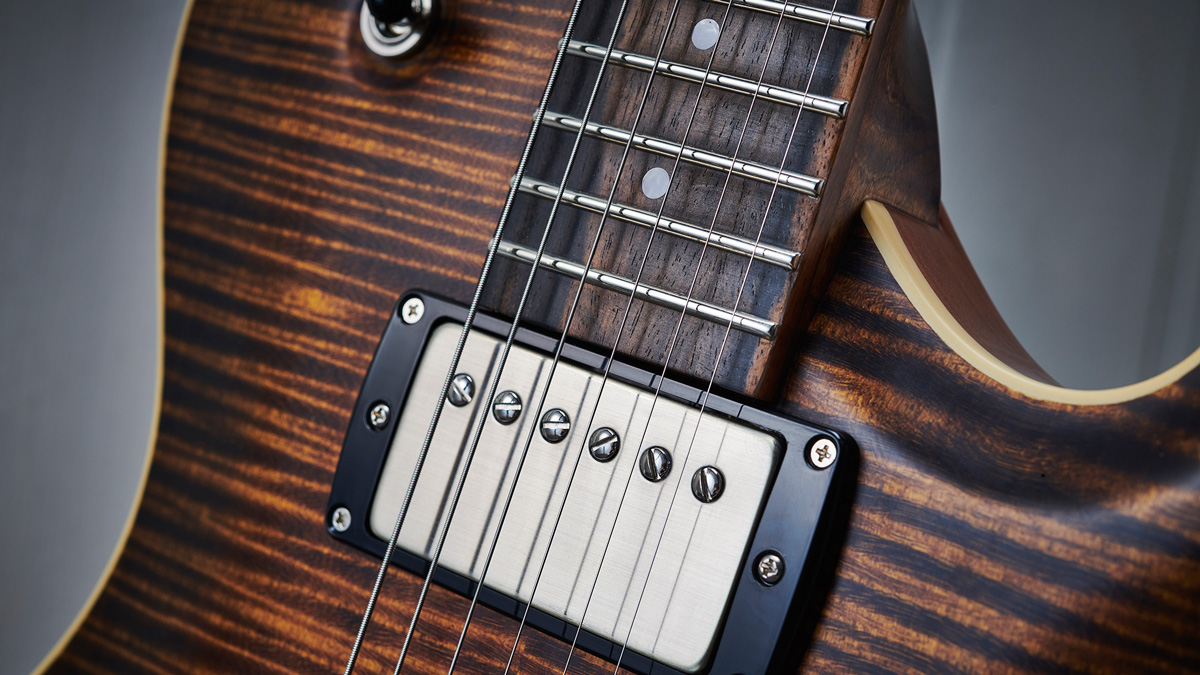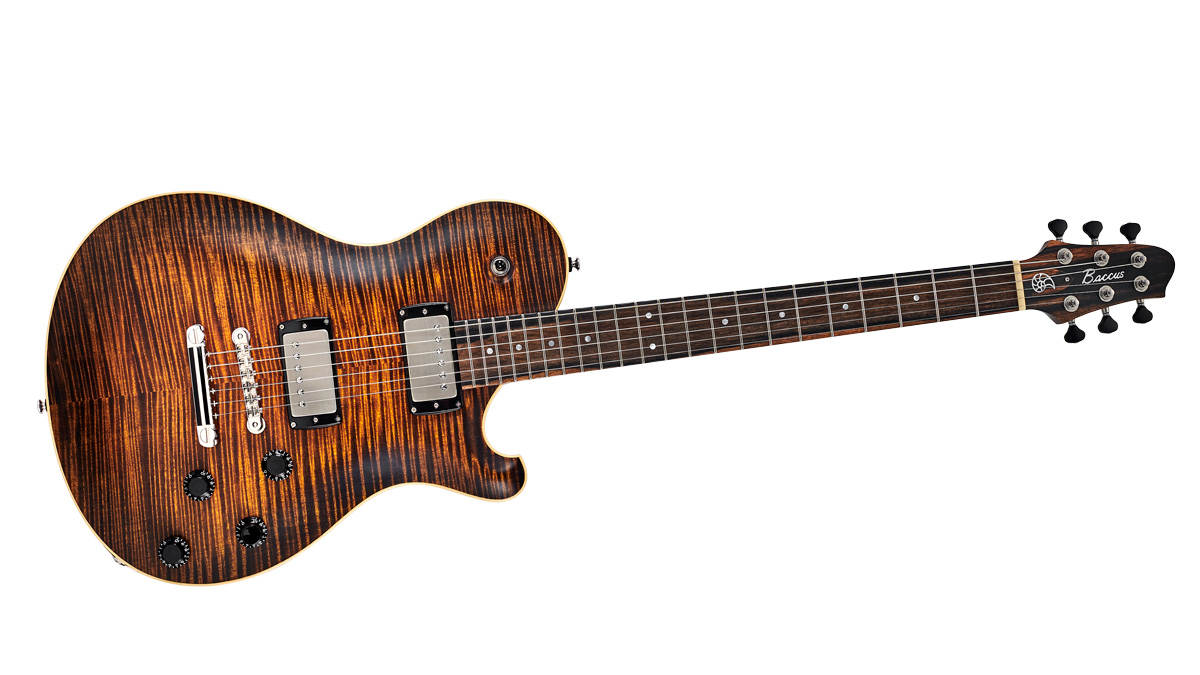MusicRadar Verdict
If you appreciate the craft and want to go ‘custom’, then here’s an exceptional place to start your journey.
Pros
- +
Detailed build.
- +
Great neck feel.
- +
Strong, versatile sounds.
- +
A real professional’s guitar.
Cons
- -
It’s no cheap date, but is well priced for its quality and style.
MusicRadar's got your back
Seth Baccus has had guitar experience at the highest level as the stepson of Andy Manson, whom we know as one of the UK making founders, along with his brother, Hugh.
Seth worked at Mansons Guitar Shop for 12 years, eight as the manager, and built his first guitar in 2004. He’s had on-the-road experience with John Paul Jones (including the Led Zepp reunion rehearsals and live shows) and worked with local mates Muse. Since 2009, he’s been crafting his own-brand guitars professionally, initially in Portugal with Andy Mason who relocated there in 2010, and now back in the UK.
The Nautilus here certainly has some of the Manson DNA with an outline that seems to meld a Telecaster with the style of a Les Paul, although side by side with both, it looks very much its own thing. Like Andy Manson’s designs (and his brother, Hugh’s), there’s that line that flows from the rounded upper shoulder into the cup of the single cutaway and up into quite a small horn that has an inward-pointing tip here.

“It primarily it comes from Andy and his original Bluebird design that he came up with in the early 90s,” explains Seth. “He was trying to build an acoustic guitar that a Telecaster player would play sitting in the kitchen or wherever. An intimate ‘home’ guitar, an acoustic guitar that was very playable and with good high-fret access. It was the shape of that line from the top shoulder into the cutaway; it just got me the first time I ever saw it.
“So when I came to design my own range of guitars - I’d been working with Andy for a few years by that point - it sort of seemed fitting to pay homage to where my education had come from in the design of the guitar. Likewise, the headstock: Andy’s is an asymmetrical shape and I’ve added some symmetry and made it fit an electric-style guitar. But, yes, it’s very much inspired by Andy’s work.”
Perhaps unusually for its style, it centres on a Fender-like scale. “A kind of hybrid between the Les Paul I wanted but the Fender [Telecaster] that felt more comfortable to play, that’s where the Nautilus concept came from,” says Seth. The body is approximately 330mm (13 inches) wide by 445mm (17.5 inches) long, and trimmer in depth than a Les Paul at 50mm falling to approximately 41mm by the rim, with a beautifully graduated violin-like arching to the top carve. There’s no ribcage cutaway on the one-piece Spanish cedar back, and its relatively plain mahogany-like colour and grain is left pretty natural. It’s in stark contrast to both the single cream-bound figured maple top and the figured maple neck, which have a darker, almost antique-like colouration that ties in perfectly with the unbound ebony fingerboard and headstock facing. The finish all over is a very silky satin, rather than high gloss, which feels quite wonderful to the touch.
It seemed fitting to pay homage to where my eduction had come from in the design of the guitar
Seth Baccus
The neck is a combination of two highly figured quarter-sawn pieces of maple with a central rosewood/maple/rosewood lamination, and extends full width into the body; its foot sits some 33mm under the neck pickup. There’s a very small elliptical heel that obviously follows the line of the body from that rounded upper shoulder into the cutaway.
The detail and craft is wonderful. A finish like this would show any slight tool mark, but there aren’t any. The fingerboard edges are lightly rounded, the highly polished frets have virtually domed ends, the tangs are notched so you don’t see them. Can a top nut be a thing of beauty? Well, this one is superbly cut and shaped, not a sharp edge in sight. Look and learn. There’s no bling, flame maple aside, although the dot inlays on the face and side are mother-of-pearl and subtly shine, just like the inlaid headstock logo and the stylised shell emblem on the ebony truss rod cover.
“The actual name, Nautilus, comes from when I was designing,” says Seth. “I was reading a lot about the mathematical equations of beauty, the Golden Ratio: specific ratios that we find all through nature. It seemed to resonate with me, visually, and the fact that it tied into something bigger. That’s where the name came from, so each has a Nautilus [shell] skeleton inlaid into the truss rod cover. It’s sort of become my whole branding - even my T-shirts have that same design.”
The neck pitch is steeper than a Telecaster but not as raked back as a Les Paul, and the tune-o-matic-style bridge sits quite low, slightly relaxing the angle of the strings to the lightweight aluminium stud tailpiece. And while the hardware is off-the-shelf, the ABM bridge (machined aluminium, not cast) is very nicely made and Gotoh’s 510 tuners need little introduction, here in a slightly aged nickel finish.
Sounds
With a full-feeling, beautifully rounded C shape, the neck is definitely in the ‘one of the best we’ve played’ category, but then it has to be, doesn’t it? It has an exceptional finish. Late-50s Les Paul springs to mind; it’s certainly in that style with a depth at the 1st fret of 22.2mm, filling out by the 12th to 24.8mm, combined with a nut width of just over 43mm. The setup suits the style with a string height of 1.6mm on both treble and bass sides and enough relief to give a clean response in the heat of action when you want to dig in. With apologies to the ladies, it feels pretty manly. But it certainly hasn’t been on the pies and pints, and weighs in just a shade over 3.6kg (8lb), which - along with its geometry - makes a much more comfortable single-cut played seated, and strapped on it hangs beautifully.
The acoustic voice is vibrant with a quick attack and a bloom to the decay that’s what this design is all about. The whole structure is working very hard. Here is a guitar that you’ll get completely lost in. We’re not joking when we say we had to limit our test time, otherwise we’d never get these words written. It’s not that the Nautilus is particularly different in terms of its style, or even sound. It’s just that at no point do we want to stop playing it. The neck shape and feel is sublime. Tuning stability and intonation should be a given at this price point, but it never fails to impress: we barely touch the tuners and never think to check the intonation, the string height and action, or the pickup heights. The only slight adjustment is getting used to the subtly different position of the controls, even though their function is second nature as it follows Gibson’s classic protocol.
There’s immense personality in this build, referencing the classics but flavoured with the pioneering style of Andy Manson
Not every guitar that offers coil-splits impresses, but here the clean single-coil voicings just extend the sonic range, as they should, without making you think they sound overly thin or brittle. The controls feel nicely damped but not over-stiff or too sloppy. Reducing the volumes just pulls back the highs as you’d expect; the full roll-off on the tone is far from unusable and before that point is very nicely balanced.
There’s a very balanced feel to the response right across the fingerboard, and even the fretwire sits perfectly between ‘vintage small’ and ‘rocky big’. It’s the things you don’t notice that impress: the perfect balance between the pickups, the graduation of sounds from bridge to neck, without thinking the former is a little sharp or overly honky, or the neck is too forward and possibly too thick. It isn’t.
Nor do we feel that the heft of the design overtakes us and becomes over-thick. Perhaps that’s down to the longer Fender scale, or perhaps the maple and ebony neck combination, but where some could sound overly bright and even crisp, here we have clarity when we want it, but it’s very balanced. It’s a single-cut that covers considerable ground.
With exemplary craft and a unique yet far from outlandish style, Seth Baccus is typical of the modern independent guitar maker. There’s immense personality in this build, which references the classics but is flavoured with the pioneering style
of his stepdad, Andy Manson. And with a decade of self-builds behind him, that hard-earned experience really shows. But it’s not about just the craft: this is a hugely usable, inspirational, pro-level guitar that mixes, by design, a Les Paul with a Telecaster and comes out like a perfect blend of the two. In that regard, it’s not completely unique but is easily on par with some of the bigger-name independent makers such as Nik Huber or Patrick James Eggle. It’s not for everyone, of course, but if you appreciate the craft and want to go ‘custom’, then here’s an exceptional place to start your journey.
Dave Burrluck is one of the world’s most experienced guitar journalists, who started writing back in the '80s for International Musician and Recording World, co-founded The Guitar Magazine and has been the Gear Reviews Editor of Guitarist magazine for the past two decades. Along the way, Dave has been the sole author of The PRS Guitar Book and The Player's Guide to Guitar Maintenance as well as contributing to numerous other books on the electric guitar. Dave is an active gigging and recording musician and still finds time to make, repair and mod guitars, not least for Guitarist’s The Mod Squad.
“We were arguing a lot and we were miserable”: How Green Day exceeded expectations with their most ambitious song
"There’s plenty for us guitarists to learn – and ‘less is more’ is the overriding lesson": how to play like George Harrison on The Beatles' Abbey Road
“They didn’t like Prince’s bikini underwear”: Prince’s support sets for the The Rolling Stones in 1981 are remembered as disastrous, but guitarist Dez Dickerson says that the the crowd reaction wasn’t as bad as people think











